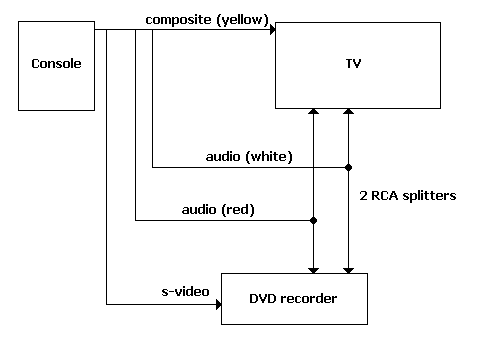Splitters
From SDA Knowledge Base
No matter what system you are recording, you'll need to find some way of getting video footage from your television to your recording device at the same time.
Powered Splitters
Powered splitters, also known as distribution amplifiers, are devices that to take A/V footage, duplicate it, and send it to multiple outputs simultaneously. You plug in your console's A/V connectors to the input connectors and then hook up your capture device and television to the outputs. Done. The process happens instantaneously. You don't have to worry about any kind of delay. The only problem with splitters is that they can be a little bit pricey. They can be approximately $30-150 depending on the type of connector. Powered splitters are available for every A/V connector and support all different resolutions. You just need to make sure that you get the appropriate splitter for the cable connector that you are using.
Composite/S-Video splitters - If you are buying a composite video splitter, make sure you grab a model that has S-Video connectors as well
Component Splitter - (often component splitters will have composite video connectors, but they won't have S-Video)
HDMI Splitters - Usually these splitters only have HDMI connectors
Cable Methods

This method is only available for consoles that support S-Video. You get an A/V connector that has both a composite video connector and an S-Video connector. You plug in the S-Video connector to your recording device and the composite video connector into your television. This actually works because your console is sending out video signal over the composite and S-Video connectors at the same time.
Depending on the A/V cables you're working with, it might be tough to physically connect the cables in this way. You might have to get an extender cable. For audio, you will need to get RCA audio splitter cables. There will be a slight, but not significant loss in audio quality. The Super Nintendo, Nintendo 64, GameCube, Wii, and Wii U all have third party A/V connectors you can use this method with.
NOTE: This cable method only works with standard definition. You can't do this with component video or HDMI.
TV Out
This isn't a common feature on televisions, but a few models have it. The television is able to display the A/V signal on the screen and instantly send the A/V signal to another device. If you are recording in standard definition and you have a television that supports this feature, you can connect your cables from your console to your television and from the television to your recording device. The TV out feature only supports standard definition composite video connectors and not S-Video.
Passthrough
This is a feature that is available with some high definition capture cards. The capture card has an A/V input connector which you connect to your console and an A/V output connector which you connect to your television. The capture card is able to simultaneously capture the signal and send it over to your television. If your capture card supports this, you may not need a powered splitter.



